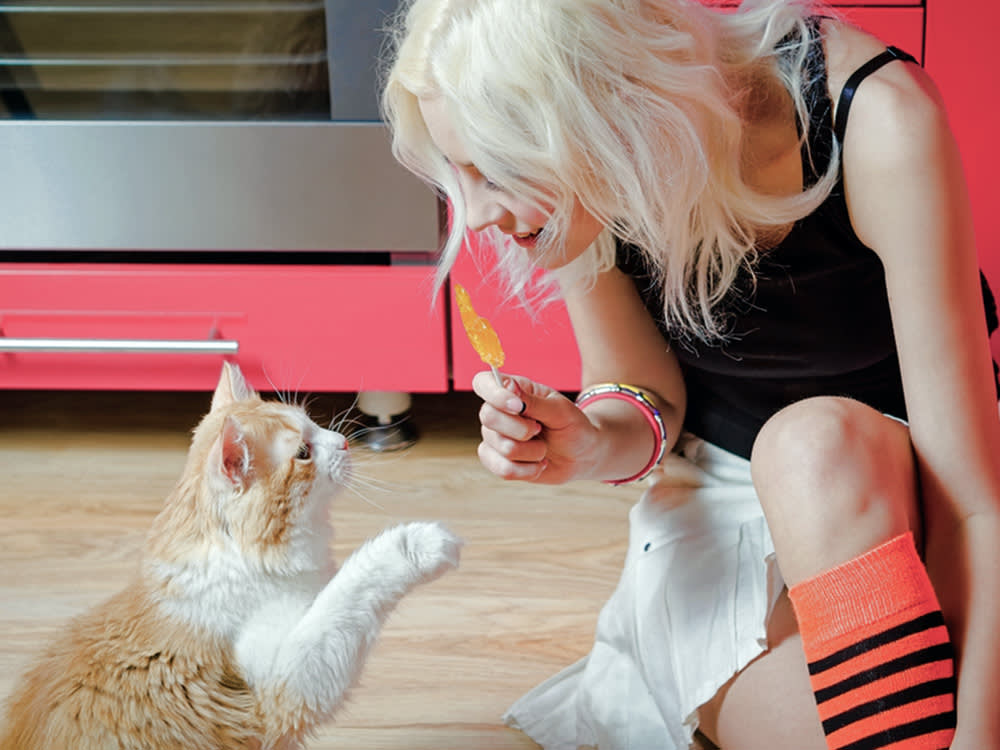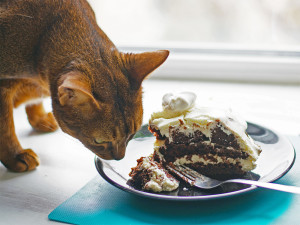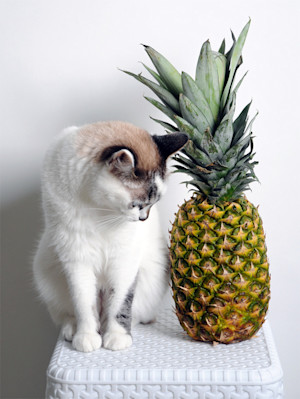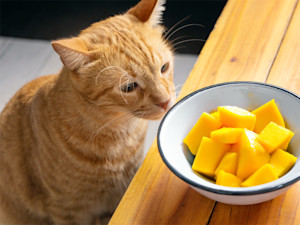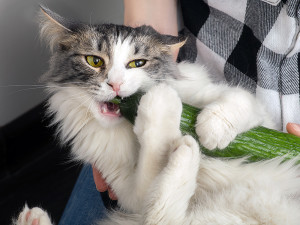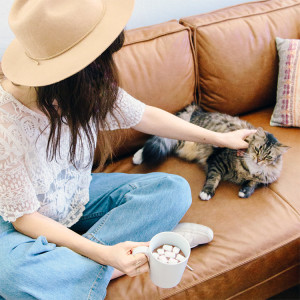With summer well underway, popsicle season is upon us with an endless variety of frozen desserts that seem to bloom in the heat. You may be wondering if your cat can eat a bit of popsicle. The answer is yes and no. While there are many varieties of popsicles that are non-toxic to cats, they are not a healthy food for cats to eat on the regular.
Many cats may not like them, either. Read on to learn more about cats and popsicles.
Nutrition facts: Popsicles for cats
Popsicles come in endless varieties with all sorts of combinations of flavors, colors, shapes, and ingredients. Some are made from whole fruits while others have more processed ingredients, or a more unique combinations of flavors.
In general, popsicles tend to contain lots of water, sugar, and high-fructose corn syrup, as well as fruit juice or other fruit flavoring and preservatives like citric acid, guar gum and food dye. Depending on the flavor, some popsicles may be dairy-based or use soy protein as an additive for flavor and texture.
How much do you spend on your pet per year?
Are popsicles good for cats?
Popsicles are not considered good for cats due to the fact that they lack most of the nutrients cats really need and tend to be excessively sweet. There are a few benefits that popsicles can provide, however:
High water content: Most popsicles are water-based and tend to have a high water content. This can be beneficial for cats since they’re not big water drinkers. For cats with certain health conditions like urinary problems or kidney disease, it is important for them to drink more water. Finding creative ways to increase their water intake may be necessary. In those cases, if you have a cat who likes popsicles, finding one that is healthier for cats, or making homemade cat-friendly popsicles, may be the best way to get the benefits without the unwanted ingredients.
Cool and refreshing: On the hottest days, it is important to find ways to keep your cats cool. Hopefully your cat has a cool, shady place to lounge, but if you find yourself stuck in a hot situation, encouraging your cat to eat cold foods can help. It may also help cats who have sore tongues or throats due to certain viruses that cause ulcers in the mouth. Again, it is important to choose wisely and find a popsicle that is relatively healthy for your cat to snack on in those cases.
Can cats eat other frozen treats?
Each frozen treat carries its own unique ingredient list and considerations. It’s important to review the ingredient label and make sure anything you intend to share with your cat is actually safe for them.
Try to avoid any frozen treats that contain a lot of sugar, dairy, or possibly toxic ingredients that are unsafe and unhealthy for cats. If you really want your cat to experience the joy of a frozen treat, you may be best off making your own kitty-safe popsicles from a low-sodium chicken broth or plain yogurt.
Also, keep in mind that many cats do not like cold or frozen foods, so don’t take it personally if your cat snubs the frozen treat you offer. Cats are classic hunters and relish eating their food when it is freshly caught and still warm. Most even prefer their canned food at room temperature or slightly warm. Frozen food just isn’t their thing.
Are popsicles completely safe for cats?
Popsicles are not completely safe for cats. There are some important considerations to keep in mind before sharing them. In some cases, a lick here and there may be fine but others need to be avoided altogether. Here are some points to keep in mind:
High sugar content: Most popsicles are high in sugar or high-fructose corn syrup, which makes them delicious to us, but not healthy for cats. Cats are obligate carnivores and do not process and metabolize sugars like we do. They are more prone to weight gain and health problems like diabetes so they should not have a lot of simple sugars in their diet. Don’t feel too bad, though; cats don’t even have the taste receptors to enjoy the sweet taste of most foods, so they can’t even really appreciate them.
Beware of other ingredients: Depending on the popsicle, some may contain ingredients that are potentially toxic to cats as well. For example, any popsicles that contain chocolate, xylitol, or are grape-based cannot be shared at all. It is also a good idea to avoid feeding your cat foods rich in dairy as they cannot properly break it down and it can lead to digestive upset like vomiting or diarrhea.
Watch the stick: Your cat may not like the popsicle itself but many will be intrigued by the stick. Avoid letting your cat chew on the stick as it may splinter, creating sharp edges that can injure their mouths or throats. If they are able to swallow large pieces of the stick, it can also lead to more serious intestinal blockages, too.
The bottom line: Can cats eat human food?
There are many human foods that cats can eat so even though popsicles may not be one of them, don’t despair. Since cats are obligate carnivores, they have higher demands for protein and fats while having less need for carbohydrates. When considering which foods to share with your cat, keep this in mind and focus on plain, lean meats and the kinds of fruits and vegetables that are lower in sugar. Be sure to double-check that whatever you plan to share is actually safe for your cat as there are some foods that are also potentially toxic or unhealthy for cats.
It is also worth emphasizing that as obligate carnivores, cats have unique nutritional needs that are quite different from omnivores like humans and dogs. For this reason, it is really important that the bulk of their diet come from a complete and balanced cat food diet designed to meet their needs. If they eat too many treats or table scraps, they may not get enough of the nutrients they really need from their cat food.
Or they may overeat if they are eating all of their cat food plus lots of treats and table scraps. This can put them at risk for weight gain and other related health problems. The best way to keep this all in check is to make sure that the majority of their intake — at least 90 percent — comes from their cat food, and that treats and table scraps are ten percent or less. This ensures your cat can live their healthiest, best, nine lives.
Other foods that are safe for cats
Shrimp is a high-protein snack option.
Cucumbers are refreshing and safe in moderation.
Apples are also safe in small amounts.
Other foods that are dangerous for cats
Garlic is toxic to cats and should be completely avoided.
Hot dogs should not be shared for many reasons.
Avoid cinnamon as well; cats don’t like it and it can be harmful in large amounts.
FAQs (People also ask)
How many popsicles can a cat eat?
Cats should not have more than the occasional lick of a popsicle as they are too high in sugar to be consumed in large amounts.
Is it OK to give cats popsicles?
The occasional lick is ok as long as it does not have any potentially toxic ingredients. However, they are not healthy for cats.
Why do cats like popsicles?
Most cats actually don’t like popsicles because of their cold sensation. Cats also cannot taste sweet flavors.
Can cats eat popsicles?
An occasional lick may be ok, but they should not eat large amounts.
Are popsicles good for cats?
No, popsicles are not good for cats.
Can cats eat other frozen desserts?
This depends on the ingredients, as some may not be safe for cats to eat. Anything with a lot of sugar should be avoided.
